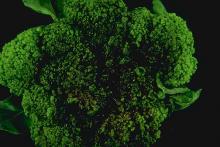Cause The soft-rot bacterium, Pectobacterium carotovorum subsp. carotovorum (syn. Erwinia carotovora var. carotovora), enters through natural openings or wounds caused by insects and equipment. Pseudomonas spp. have been isolated from diseased heads and are thought to actively infect the host. Prolonged moisture from rain or irrigation and mild temperatures encourage disease development. Bacteria survive in soil and plant debris.
Symptoms Any plant part can be affected, but the most serious economic loss is from head infections. Plant tissue at first appears water-soaked and rapidly breaks down into a soft, mushy rot.
Cultural control
- Set out plant rows that will allow good air drainage.
- Cultivate carefully to minimize injuring plants.
- Control frequency and source of irrigation water.
- Avoid frequent irrigation during head development.
- Time irrigation to allow the head to dry rapidly.
- Use well water, which generally is free of bacteria.
- Avoid stagnant water sources.
- In Tennessee, the varieties, Pirate, Shogun, Green Valiant, and Green Defender, are reported to be resistant to Pseudomonas sp., another cause of head rot. These varieties have not been evaluated in Oregon against E. carotovora.
- Keep storage house humidity between 90% and 95% and the temperature between 32°F and 39°F.
Chemical control
- Cueva (Group M1) at 0.5 to 2 gal/100 gal water on 7- to 10-day intervals. May be applied on the day of harvest. 4-hr reentry. O
Biological control Efficacy unknown in Oregon.
- Cease at 3 to 6 quarts in 100 gal water. For greenhouse plants only. Preharvest interval is 0 days. 4-hr reentry. O
References Canaday, C.H., Wyatt, J.E., and Mullins, J.A. 1991. Resistance in broccoli to bacterial soft rot caused by Pseudomonas marginalis and fluorescent Pseudomonas species. Plant Disease 75:715-720.
Ludy, R.L., Powelson, M.L., and Hemphill, D.D. 1997. Effect of sprinkler irrigation on bacterial soft rot and yield of broccoli. Plant Disease81:614-618.

